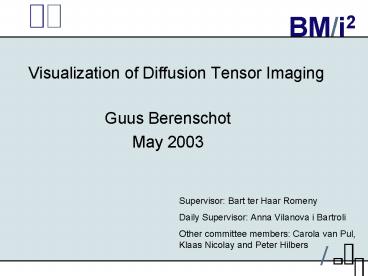Visualization of Diffusion Tensor Imaging - PowerPoint PPT Presentation
1 / 23
Title:
Visualization of Diffusion Tensor Imaging
Description:
Linear Anisotropy (Cl) falls below a certain threshold. Angle in a fiber is too big ... Planar anisotropy can be due to kissing crossing or branching fibers. 12 ... – PowerPoint PPT presentation
Number of Views:400
Avg rating:3.0/5.0
Title: Visualization of Diffusion Tensor Imaging
1
Visualization of Diffusion Tensor Imaging
- Guus Berenschot
- May 2003
Supervisor Bart ter Haar Romeny Daily
Supervisor Anna Vilanova i Bartroli Other
committee members Carola van Pul, Klaas Nicolay
and Peter Hilbers
2
Contents
- Introduction Diffusion Tensor Imaging (DTI)
- Visualization Tool for DTI
- Demonstration
- Conclusion and Future Work
3
Introduction Diffusion Tensor Imaging
- Diffusion is the random motion of molecules, and
is characterized by a diffusion coefficient D. - In tissue this diffusion hindered by physical
barriers. - The diffusion coefficient is called Apparent
Diffusion Coefficient (ADC)
4
Introduction Diffusion Tensor Imaging
- Diffusion Tensor Imaging is a Magnetic Resonance
Imaging (MRI) technique. - DTI measures the ADC in 6 directions and computes
a symmetric diffusion tensor (D) of this - This diffusion tensor is defined for each voxel
in the 3D dataset
5
Diagonalization Diffusion Tensor
- Diagonalization of this tensor provides three
eigenvectors (ev1, ev2 and ev3) with three
corresponding eigenvalues (?1, ?2 and ?3)
6
Anisotropy Indices
- Linear case
- Planar case
- Isotropic case
7
Problem Definition
- How to extract meaningful information of a 3D DTI
dataset??? - Neonatal brain (Maxima Medical Center, Veldhoven)
- Muscles (Magnetic Resonance Laboratory)
8
Visualization Tool For DTI
- Anatomical reference
- Displaying local tensor information
- Displaying global tensor information
- Improvements to existing techniques
9
Multi Planar Reconstruction Planes
- Anatomical reference
- Displaying local tensor information in 2D slice
10
Anisotropy Indices
- Colorcoding anisotropy indices
11
Colorcoding Main Diffusion Direction
- Colorcoding directions
- Intensity color scaled with anisotropy index
Pajevic et al. 1997
12
Glyphing
- Glyphs are icons that represent the local tensor
information - Two types of glyphs can be displayed
- Ellipsoids
- Cuboids (Worth et al., 1998)
13
Cuboids
14
Fiber Tracking Introduction
- Fiber tracking simplifies the tensor field to the
vector field of the main eigenvector - This vector field is made continuous by
interpolation - Consider this vector field as a velocity field
and drop a free particle on it - This particle will follow a trajectory
- The found trajectory can be seen as a bundle of
fibers
Xue et al. 1999, Conturo et al. 1999, Mori et
al. 1999
15
Tracking
- The tracking can be seen as solving the following
integral - To solve this integral we use a second order
Runge Kutta integration
16
Seed Points
- Manual definition of a seed point or seed region
- Start tracking in all voxels and keep the
trajectories that pass a certain region
Stopping Criteria
- Linear Anisotropy (Cl) falls below a certain
threshold - Angle in a fiber is too big
17
Fiber Tracking In Healthy Volunteer
Optical tract Corpus Callosum
18
- Patient with a tumor
Neonatal brain
Mouse muscle
19
Surface Building
- Fiber tracking gives problems in regions with
planar anisotropy the main eigenvector is not
reliable - Planar anisotropy can be due to kissing crossing
or branching fibers
20
Surface Building
- If we enter a region with planar anisotropy
follow all directions defined by local plane and
display a surface here - If anisotropy is linear again do the common
fiber tracking.
21
Demonstration
22
Conclusion
- The visualization tool is considered as very
useful by the MMC and the MRL - Results of fiber tracking in neonatal brain is
promising
Future Work
- Seeding is biased
- Noisy data-gt smoothing
- Quantitative information of fibers
23
Thanks
- Anna Vilanova i Bartroli (daily supervisor)
- Bart ter Haar Romeny (supervisor)
- Gustav Strijkers and Anneriet Heemskerk (MRL)
- Carola van Pul and Maurice Jansen (MMC)
- George Roos and Jan Buijs (radiologist and
neonatologist MMC) - Klaas Nicolay and Peter Hilbers (committee
members)































